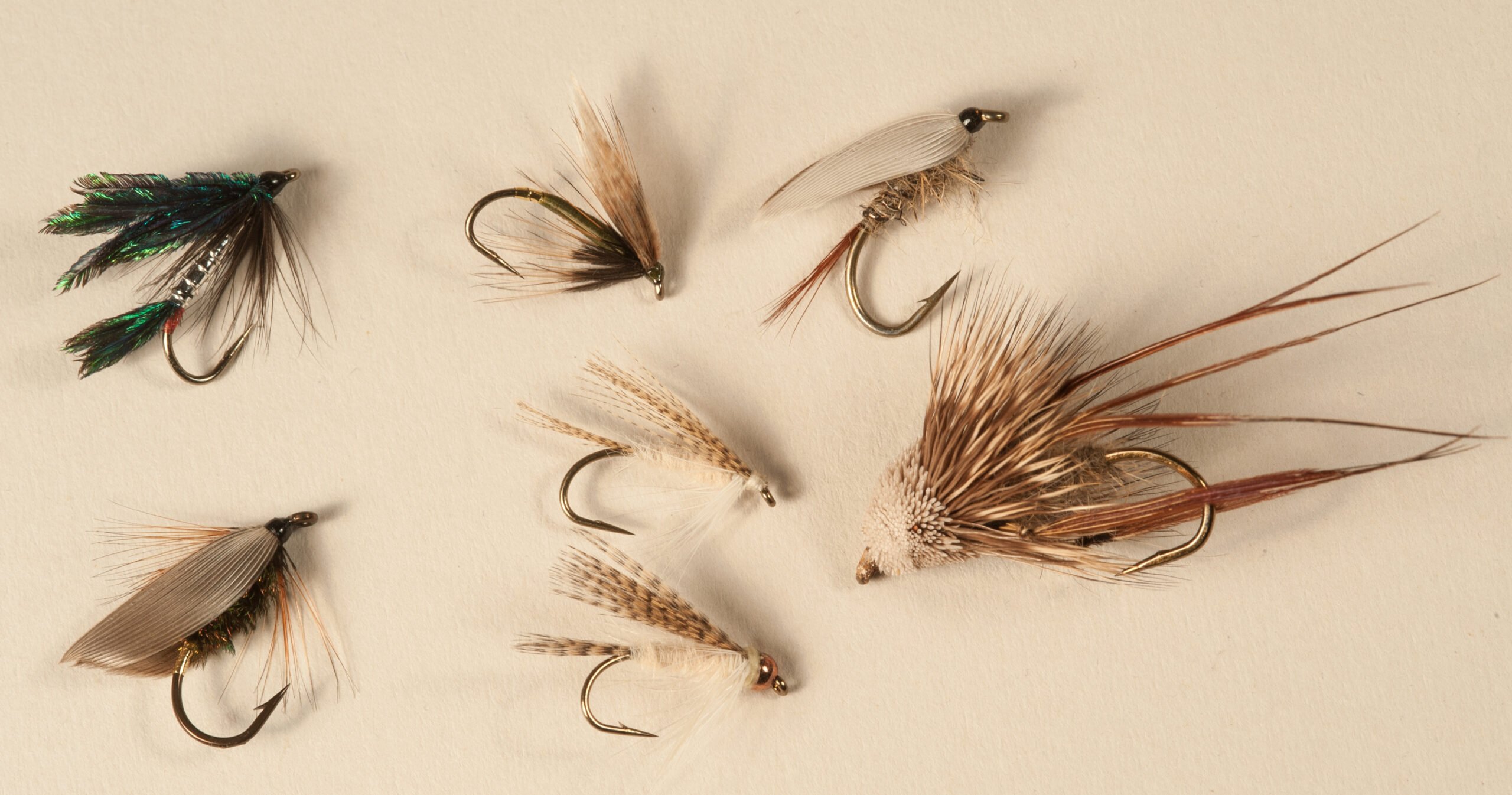In my 1952 second edition of Ray Bergman’s beefy classic volume, “Trout,” there are dressings for and paintings of 476 wet flies. Clearly, you can drown yourself in wet-fly patterns — just as you can with dry-fly, emerger, nymph, and streamer patterns. So, I’ll offer a very manageable selection of a few wets that will carry you a long way. ~ Skip Morris
Here are 6 bonus patterns from One Man’s Way to Catch Cranky Trout by Skip Morris. The full article can be found in the Spring 2025 Issue, now out.
Alexandra
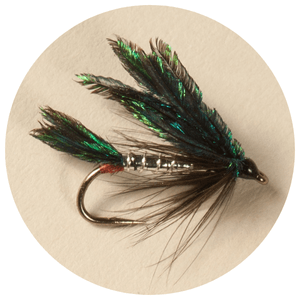
As I’ve said: a classic, a stunner, and a proven attractor wet fly.
Hook: heavy wire, standard length (though I prefer 1X long, specifically the Daiichi 1560), sizes 14 to 8
Thread: black 6/0 or 8/0
Tip (optional): red or dark-red floss
Tail: peacock sword, or a section of dyed-red or dyed-scarlet duck or goose quill, or the quill atop the sword or the sword atop the quill
Rib (optional . . . supposedly. I consider it obligatory): oval silver tinsel (though I prefer heavy silver wire—I can really bear down on the strong wire so it doesn’t slip on the smoothness of the flat-tinsel body)
Body: flat silver tinsel
Hackle: black (or “wine,” a dark purplish red) hen-neck
Wing: peacock sword. Something red, (probably duck or goose quill sections) alongside or along the lower edge of the sword, is optional
My fly-pattern books, dating back to 1952, bounce all around on the details of the Alexandra, a fact reflected in the dressing above. Still, the wing and body stay nearly stable, and the hackle really is usually black. However you tie it the Alexandra retains its beauty, remains unique among the many wet-fly patterns, and catches trout that are in a curious or playful mood.
Cowdung
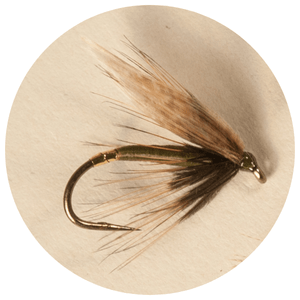
Covers the green-bodied bugs. And what a pleasure to pluck its lovely self from a fly box and work it in fingers while tying it to a tippet.
Hook: heavy wire, standard length (though I prefer 1X long, specifically the Daiichi 1560), sizes 16 to 10
Thread: black or brown (though I often cheat on this one: olive) 8/0 or 6/0
Tip (optional apparently, but not to me): flat gold tinsel
Body: green or olive floss (or wool, but I doubt anyone uses wool today. And some of my old books list dark olive)
Hackle: brown (or dark-ginger, at least one of my old pattern books so says) hen-neck
Wings: mottled oak turkey primary (one of my old pattern books lists natural gray duck-primary sections—a travesty!)
I love this old classic wet. As do trout for its quiet natural coloring.
Hare’s Ear Wet (Sometimes called the Gold-Ribbed Hare’s Ear Wet)
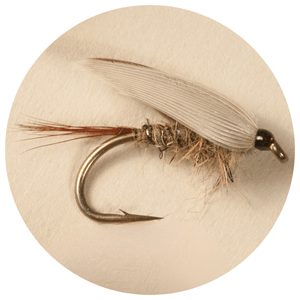
This wet-fly version of the Hare’s Ear nymph bears the nymph’s neutral shades that suggest caddis, mayfly — it covers well any that aren’t really pale or really dark. For dark, there’s the Leadwing; for pale, the Light Cahill.
Hook: heavy wire, standard length (though I prefer 1X long, specifically the Daiichi 1560), sizes 16 to 10
Thread: black (though brown is more natural, looks good, makes sense) 8/0 or 6/0
Tail: brown hen-neck or back fibers or bronze mallard—but why not partridge-flank or pheasant tail or the standard for the nymph version of the pattern, guard hairs from a hare’s mask?
Rib: oval gold tinsel
Body: hare’s mask
Hackle: pointy guard hairs teased out of the built-up thorax-area
Wings: natural-gray duck-primary sections
Somber with the glint of metallic gold, the Hare’s Ear Wet suggests a broad range of winged bugs.
Leadwing Coachman
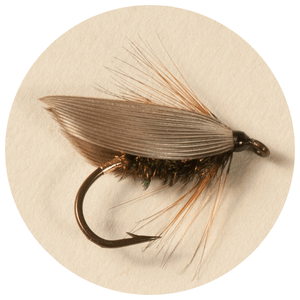
Dark, dark, for the dark mays and caddis.
Hook: heavy wire, standard length (though I prefer 1X long, specifically the Daiichi 1560), sizes 16 to 8 (some of my older books say up to 6, to which I say, “Where on God’s earth would you fish a size 6 wet fly, and why?”)
Thread: black 6/0 or 8/0
Tip (designated optional in one of my old pattern books, but I find the fly a tad dull without it): flat gold tinsel
Body: peacock herl
Hackle: brown hen-neck
Wings: natural-gray duck-primary sections
Simple, dark, proven.
Light Cahill Wet
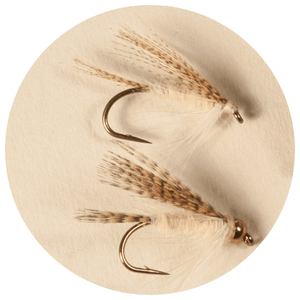
For pale winged underwater swimmers (the Pale Morning Dun is the obvious target).
Hook: heavy wire, standard length (though I prefer 1X long, specifically the Daiichi 1560), sizes 16 to 10
Thread: cream or tan 8/0 or 6/0
Tail wood-duck (or mallard-dyed-wood-duck) feather fibers
Body: cream fox or rabbit fur
Hackle: ginger hen-neck
Wing: wood-duck (or mallard-dyed-wood-duck) feather fibers
I long ago fell for the Light Cahill dry fly, then, also, for the Parachute Light Cahill. This wet-fly version is a fairly recent infatuation.
Muddler Daddy
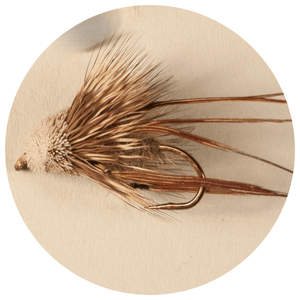
Those knotted long legs surely do some real waving down there in shifting currents. (Davy knots each pheasant-tail leg twice; laziness, being my chief work ethic, dictates a single knot per leg.) I doubt the fly imitates anything; I do not doubt Davy’s faith in it or Davy’s faith in a fly as first-rate validation.
Hook: standard wire, 2X long sizes 12 and 10 or 1X long size 10
Thread: olive, tan, or brown 6/0 (I use size A rod-thread for to making the flared-hair collar and head)
Rib/Body Hackle: fine silver or gold wire, a smallish light-ginger dry fly saddle hackle spiraled up the body (I generally pass on the rib and body hackle)
Body: hare’s mask
Legs: six pheasant-tail fibers knotted twice each (for me: four legs of one knot each)
Hackle: natural-brown partridge, long, behind the hair-tips collar, extending beyond the tips of the hair. (Being a troglodyte, or, put more gently, a pragmatist, I pass on the hackle. It does add a nice touch though)
Collar and Head: deer hair, the tips of the first hair-bunch for the collar. Trim the flared hair to a large head like a Muddler Minnow head
A sort of Muddler Minnow/cranefly adult. On those occasions when I swing two wets, I like it for a point fly, where I can picture its legs swaying in the current.
Size
I’d go sizes 14, and 12 for all. And you’d be wise to bring at least two of each size to the water.
